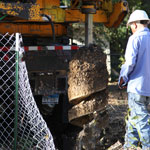Home to big-name employers such as Boeing, Amazon, and Microsoft, Seattle has become an increasingly popular living destination over the past decade and a half, so it’s little wonder that local builder American Classic Homes (ACH) now pays to show up as an advertiser every time an individual queries Google about relocating there. And from the results of the firm’s campaign, it sometimes feels like every corner of the world wants a piece of the Emerald City.
“Seattle in general is getting a lot of attention, both national and international,” ACH partner and CFO Joel Mezistrano says. “In fact, it’s now considered to be on the short list for core markets. Both here and in [eastern suburb] Bellevue, there’s lots of high-rise construction going on and cranes everywhere.”

In business since 1999, ACH has gone through a couple of phases. First, there was the developmental phase, when the partners could count all of their employees on one hand, output was 20–30 homes a year, and every aspect of the business was managed by cofounders Michael and Robert Gladstein. Then there was the darker phase, when the recession of 2008 ground most construction to a halt and many of the midrange local builders in the Seattle area either went out of business or got bought up by national builders that came to town. But, the economic cloud has offered a silver lining of opportunity for ACH, enabling it to snap up terrific land that others were forced to sell back to the bank, and it’s now using its still-nimble management strategies to outfit the sites with new homes and developments while attracting some of the area’s top talent.
“Some [of the properties] were truly in the most pristine locations and in the best school districts but were selling for 40 cents on the dollar,” Mezistrano says. “And we had access to some equity that made us one of the few able to buy it … at the low point of the market.”
Since its early days of spec-home building, ACH has not only boosted its productivity but its capabilities, and it now builds an average of 100 homes a year, including single-family units, full housing developments, and apartment complexes. At the same time, though, it has remained small enough for the Gladsteins and Mezistrano to meet once a week and review the status of all homes in production. Mezistrano says construction purchasing, scheduling, and other time-consuming tasks are all streamlined thanks to automated systems. “We’re not looking to add additional layers,” he says. “We try to stay pretty lean and mean in the back office so that we don’t have to build a certain number of homes just to keep the lights on.”
Keeping ACH busy these days is a typical mix of projects, including Windsor Circle, Brookefield, and Panther Ridge—three communities with a total of roughly 51 homes, almost all of which are already presold. The firm will also break ground this year on a 162-unit, garden-style apartment complex sited near Boeing’s 737 plant. “From a financial point of view, multifamily units make sense,” Robert says. “It’s a good hedge against single-family homes, and multifamily will do better as interest rates go up.”
Multifamily projects are also a more effective use of undeveloped land, which is becoming increasingly scarce in the Seattle area. Now that the construction industry is coming back from the economic brink, ACH is growing used to frequent competition for key pieces of property. “It’s been interesting,” Mezistrano says. “We’ve seen some of the biggest builders in the United States do 10- to 12-lot plats here, but there’s going to be a shake-out eventually. There’s just not enough in the core areas to feed everybody; still, everyone’s trying to establish a presence. It’s a bit of a frenzy.”

“We’ve seen some of the biggest builders in the United States do 10- to 12-lot plats here, but there’s … just not enough in the core areas to feed everybody; still, everyone’s trying to establish a presence. It’s a bit of a frenzy.”
joel mezistrano, CFO & partner
One big advantage helping ACH rise above the fray is its understanding of Seattle’s international market and the sector’s impact on layouts and design. Robert points to a need for more first-floor dens and bedrooms for extended-family situations, and he also notes the importance of feng shui, particularly in the lives of East Indians and Asians. Feng shui, as it applies to homebuilding, is described by Robert as “a certain flow of how the house works.” It takes time to understand from a design perspective, but thanks to connections with highly knowledgeable real estate agents, ACH has a better grasp of the concept than most builders. “It’s not that difficult to move things around to comply [with feng shui], and we know how important it is to some clients, so we make it happen,” Robert says. “We just incorporate it from the beginning. It’s a no-brainer.”
Having survived the worst of the market, ACH has now made further connections with several of the greats in Seattle’s building industry—some of whom even work in-house for the firm. It’s yet one more advantage ACH has enjoyed by sheer virtue of its adaptability. “We got a potluck of good people after some builders went under—great salespeople,” Robert says. “And [we have] great floorplan designs that really outshine other options.”
The best thing about such workers, Mezistrano adds, is the deep local background and extra maneuverability they bring to every opportunity that comes ACH’s way. “We have some that have come from low-end [homebuilding], where volume is critical, and some from the high-end luxury homes,” he says. “We’re somewhere in the middle. It’s all come together to provide the right fit for us.”





